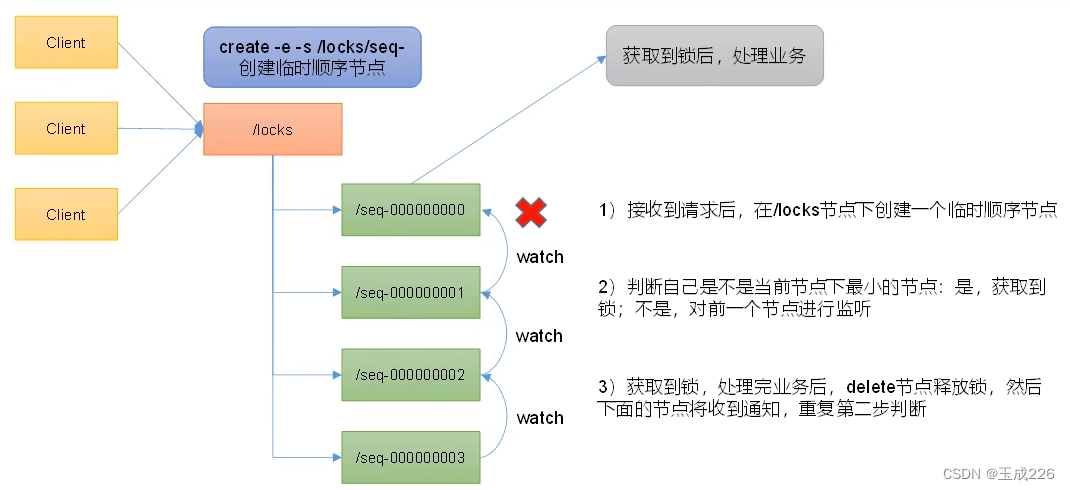文章目录
- 一、Zookeeper JavaAPI操作
- 1、Curator介绍
- 2、创建、查询、修改、删除节点
- 3、Watch事件监听
- 二、Zookeeper分布式锁原理
一、Zookeeper JavaAPI操作
1、Curator介绍
- Curator是Apache Zookeeper的Java客户端。
- 常见的Zookeeper Java API:
- 原生Java API。
- ZkClient。
- Curator。
- Curator项目目标是简化Zookeeper客户端的使用。
- Curator最初是Netfix研发的,后来捐献了Apache基金会,目前是Apache的顶级项目。
- 官网:https://curator.apache.org/docs/about
2、创建、查询、修改、删除节点
public class CuratorTest {private CuratorFramework client;@Beforepublic void init() {// 1、方式一RetryPolicy retryPolicy = new ExponentialBackoffRetry(3000, 10);CuratorFramework curatorFramework = CuratorFrameworkFactory.newClient("localhost:2181", 60 * 1000, 15 * 1000, retryPolicy);// 2、方式二CuratorFramework client = CuratorFrameworkFactory.builder().connectString("localhost:2181").sessionTimeoutMs(60 * 1000).connectionTimeoutMs(15 * 1000).retryPolicy(retryPolicy).namespace("test").build();// 开启连接client.start();this.client = client;}/*** 1、基本创建:client.create().forPath("/app1")* 2、创建节点,带有数据:client.create().forPath("/app1", data)* 3、设置节点的类型: client.create().withMode(CreateMode.EPHEMERAL).forPath("/app1")* 4、创建多级节点: client.create().creatingParentsIfNeeded().forPath("/app1/app2")*/@Testpublic void testCreate() {// 1、基本创建// 如果创建节点,没有指定数据,则默认将当前客户端的ip作为数据存储try {String path = client.create().forPath("/app1");System.out.println(path);} catch (Exception e) {throw new RuntimeException(e);}}/*** 查询节点:* 1、查询数据:get* 2、查询子节点: ls* 3、查询节点状态信息: ls -s*/@Testpublic void testQueryData() {// 1、查询数据: gettry {byte[] data = client.getData().forPath("/app1");System.out.println(new String(data));} catch (Exception e) {throw new RuntimeException(e);}}@Testpublic void testQueryChildren() {// 查询子节点: lstry {List<String> stringList = client.getChildren().forPath("/");System.out.println(stringList);} catch (Exception e) {throw new RuntimeException(e);}}@Testpublic void testQueryState() {// 查询节点状态信息: ls -sStat status = new Stat();try {client.getData().storingStatIn(status).forPath("/app1");System.out.println(status);} catch (Exception e) {throw new RuntimeException(e);}}/*** 修改数据:* 1、修改数据。* 2、根据版本修改*/@Testpublic void testSet() {// 修改数据try {client.setData().forPath("/app1", "haha".getBytes());} catch (Exception e) {throw new RuntimeException(e);}}@Testpublic void testSetForVersion() throws Exception {// 根据版本修改Stat stat = new Stat();// 查询节点状态信息: ls -sclient.getData().storingStatIn(stat).forPath("/app1");int version = stat.getVersion();client.setData().withVersion(version).forPath("/app1", "hehe".getBytes());}/*** 删除节点:delete、deleteall* 1、删除单个节点* 2、删除带有子节点的节点* 3、必须成功的删除: 为了防止网络抖动。本质就是重试。* 4、回调*/@Testpublic void testSingleDelete() throws Exception {// 1、删除单个节点client.delete().forPath("/app1");// 2、删除带有子节点的节点client.delete().deletingChildrenIfNeeded().forPath("/app1");// 3、必须成功删除client.delete().guaranteed().forPath("/app1");//4、回调client.delete().guaranteed().inBackground((client, event) -> {System.out.println("我被删除了");System.out.println(event);}).forPath("/app1");}@Afterpublic void close() {if (client != null) {client.close();}}
}
3、Watch事件监听
- Zookeeper允许用户在指定节点上注册一些Watcher,并且在一些特定事件触发的时候,Zookeeper服务端会将事件通知到感兴趣的客户端上去,该机制是Zookeeper实现分布式协调服务的重要性。
- Zookeeper中引入了Watcher机制来实现了发布/订阅功能,能够让多个订阅者同时监听某一个对象,当一个对象自身状态变化时,会通知所有订阅者。
- Zookeeper原生支持通过注册Watcher来进行事件监听,但是其使用并不是特别方便需要开发人员自己反复注册Watcher,比较繁琐。
- Curator引入了Cache来实现对Zookeeper服务端事件的监听。
- Zookeeper提供了三种Watcher:
- NodeCache:只是监听某一个特定的节点。
- PathChildrenCache:监控一个ZNode的子节点。
- TreeCache:可以监控整个树上所有节点,类似于PathChildrenCache和NodeCache的组合。
二、Zookeeper分布式锁原理



)




【独一无二】)




)

安装 postgres sql 数据库)





